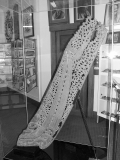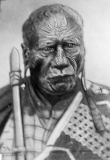Ohinemuri Regional History Journal 50, September 2006
(by Graham Watton)
ONE OF the last material links with Ngati Tamatera paramount Chief Taraia Ngakuti Te Tumuhia (1775-1872) has been restored and placed on display in the Paeroa and District Museum to become the focal point of the large collection of Maori artefacts.
The most impressive 1.8m high taurapa or stern post from the chief's waka or canoe, was carved by stone adze and is estimated to be almost 200 years old. It is only one of a very few Hauraki carvings of that era existing today.
Chief Taraia's fortified pa was on the high ground near the Historic Maritime Park. The district's first European settler, Joshua Thorp set up home in 1842, opposite the Maritime Park after buying land from Chief Taraia. The Chief was also known to have owned land at Waiomu, Thames Coast, and at Kauri Point, near Katikati.
Chief Taraia was a fierce, uncompromising old warrior until the end of his days, although he was never known to kill a white man! From his early days he was always leading his Ngati Tamatera warriors, a sub-trible of Ngati Maru, on numerous expeditions. He was one of the principal fighting chiefs of Marutuahu, a confederation of numerous and powerful tribes living in the Waihou Valley.
At one time Chief Taraia joined Chief Te Rauparaha of the Horowhenua region, on a raiding expedition against the Nga Tahu of Canterbury going as far south as Kaikoura and Kaiapoi. Upon his returned he settled at Waiomu but then made one last more foray, this time to settle an old score with the Nagti te Rangi of Katikati, who had occupied his Kauri Point land. This culminated in a Chief Taraia victory and what was reputed to be the last cannibal feast in New Zealand.
When Chief Taraia, about 1850, built a new waka, some 55ft (16.8m ) to 60ft (18.3m) long, he used the taurapa, the tauihu (prow) and other fittings from an earlier waka.
Chief Taraia was often seen sailing on the Waihou with his waka in full regalia, on his way to and from Waiomu.
Chief Taraia and George (son of Joshua) Thorp family had a very close relationship and when the Chief passed away at the aged of 97 in 1872, his waka and smaller one was left in a shed below the pa site on Thorp land. Some years later when the shed collapsed in a storm the local Ngati Tamatera gave to the taurapa, tauihu, a ceremonial bailer and another bailer to the Thorp family for safe keeping. The slowly decaying waka was used on the Waihou River, by the children of the district as a "diving board". However, during a big flood the waka broached to the strong current and sunk.
Over the years the tauihu and bailers have disappeared. The taupara was handed by Miss Leila Thorp, a daughter of George, to local historian Charles Murdock of Hikutaia who had an extensive local Maori artefact collection. When he passed away his son, Robert, passed the taupara to the Paeroa and District Historical Society to be placed in its Museum to ensure that it remained in the district.
In 1993, archaeological students working on the Raupo Pa "dig", visited the Paeroa and District Museum. They removed the taurapa from its place on the wall and, while taking photographs, dropped the taurapa causing serious damage.
For the next 12 years the taupara was stored by the Museum until last year when it was decided to have it restored and placed on view. The Museum commenced the project with Kaumatua Dick Rakina, assisted by his wife, Vera, and Peter Te Moananui blessing the carving.
Upon the project's completion Kaumatua Dick returned and was extremely delighted with the finished product. Kaumatua Fred Paraku, his wife Pauline, Lucy and Ginger Turua and Raymond Winiata from Pai o Hauraki Marae visited the Museum and Fred perfomed a formal blessing. This was significant as Fred is a direct descendant of Chief Taraia.
This project was made possible by a generous financial grant of $4004 by the Scottwood Charitable Trust. The restoration work was done by Conservator Annette McKone of Henderson, and the cabinet was supplied by Greenmount Manufacturing of Auckland.
Footnote: In the late 1960s while shooting pheasants in an isolated area on the Ohinemuri River bank, the late Bill Snelgar, found a carved sand-stone headstone. The inscription was:
Ko Taraia Ngakuti te Tumuhia
I mate ki Ohinemuri I te 13. 0
Nga ra o maehe 1872
Konoatau 97.
Translated this historic memorial says that "Chief Taraia died in Ohinemuri on March 13, 1872, at the age 97".
However, while there is no doubt he spent much of his last years in Ohinemuri, according to Maori custom he would not have been buried under the memorial stone, his resting place is in some secret grave. It is also noted that Chief Taraia was born just six years after Captain Cook sailed up the Waihou River to Netherton on November 20, 1769


